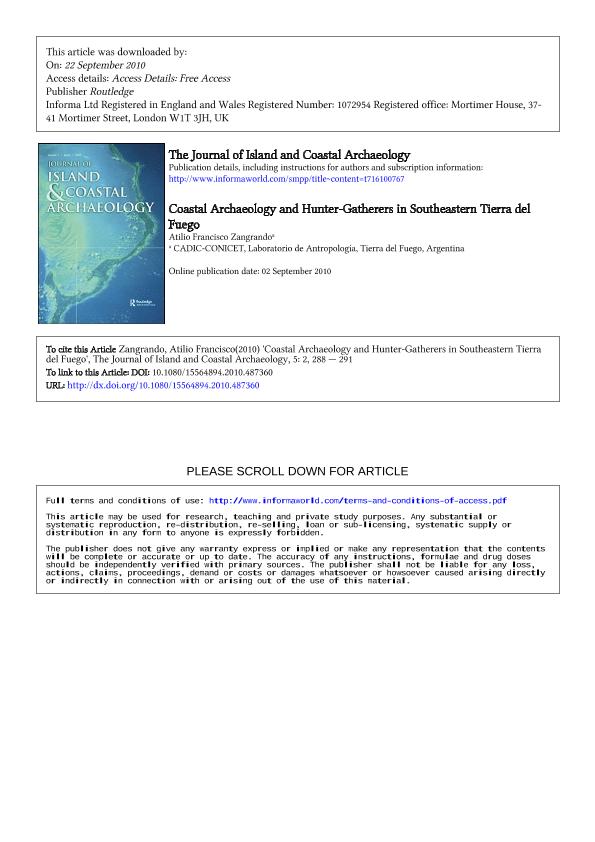Artículo
Coastal Archaeology and Hunter-Gatherers in the Southeastern Tierra del Fuego
Fecha de publicación:
09/2010
Editorial:
Taylor & Francis
Revista:
Journal of Island and Coastal Archaeology
ISSN:
1556-4894
Idioma:
Inglés
Tipo de recurso:
Artículo publicado
Clasificación temática:
Resumen
The southeastern coasts of Tierra del Fuego are archaeologically multifaceted landscapes. This may be due to the fact that these settings served as zones of interactions between biologically, culturally, and linguistically distinct co-resident groups. Abundant ethnographic information indicates that the southeastern coast of Tierra del Fuego was inhabited by both maritime (Yamana ´ ) and terrestrial (Selk’nam and Haush) populations of hunter-gatherers (Bridges 1886; Gusinde 1937; Hyades and Deniker 1891; Lothrop 1928). Although these populations maintained exchange and marriage relationships, their lifestyles were markedly different (Gusinde 1937). This population pattern is well known in historic times, but the timing and structure are still unclear for prehistoric times. It is only recently that this subject began to be assessedin the region (Zangrando et al. 2009). To improve our knowledge on the use of coastal environments and social interaction by different groups of hunter-gatherers of Tierra del Fuego, I started with an archaeological project in Moat. This is a region located in the central section of the south coast of this island, and includes all of the homonymous river basin, and the coastline extending from the mouth of Cambaceres River to Sloggett Bay (Figure 1). This study area covers approximately 1,000 km2. No archaeological research was previously developed in this region. The first goals of this project are to analyze the spatial and temporal distribution of sites, and to explore the composition of archaeological assemblages to assess the use of space and resources by hunter-gatherer populations. This research will assist in identifying contrasting subsistence and technological strategies of those groups at the same or at different points in time, and will provide clues about past habitat use and competitive/cooperative social relationships associated with resource procurement.
Palabras clave:
Moat
,
Hunter-Gatherers
,
Spatial Tendencies
Archivos asociados
Licencia
Identificadores
Colecciones
Articulos(CADIC)
Articulos de CENTRO AUSTRAL DE INVESTIGACIONES CIENTIFICAS
Articulos de CENTRO AUSTRAL DE INVESTIGACIONES CIENTIFICAS
Citación
Zangrando, Atilio Francisco Javier; Coastal Archaeology and Hunter-Gatherers in the Southeastern Tierra del Fuego; Taylor & Francis; Journal of Island and Coastal Archaeology; 5; 2; 9-2010; 288-291
Compartir
Altmétricas




